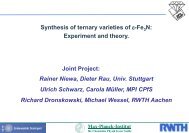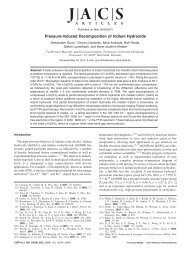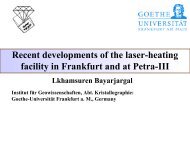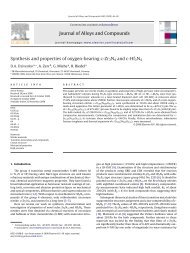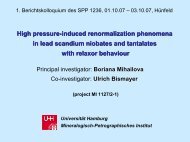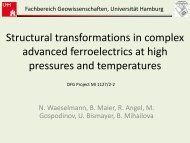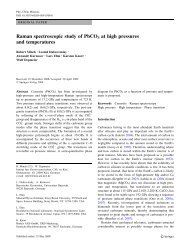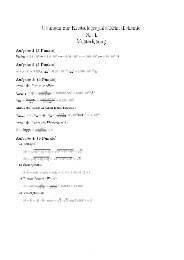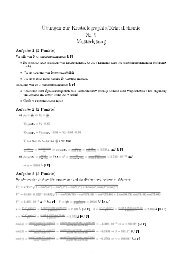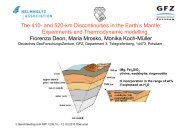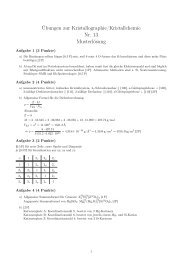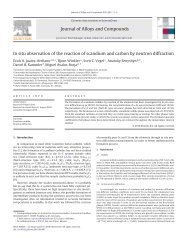High-Pressure Studies of (Mg0.9Fe0.1)2SiO4 Olivine Using Raman ...
High-Pressure Studies of (Mg0.9Fe0.1)2SiO4 Olivine Using Raman ...
High-Pressure Studies of (Mg0.9Fe0.1)2SiO4 Olivine Using Raman ...
Create successful ePaper yourself
Turn your PDF publications into a flip-book with our unique Google optimized e-Paper software.
<strong>High</strong>-<strong>Pressure</strong> <strong>Studies</strong> <strong>of</strong> (<strong>Mg0.9Fe0.1</strong>)<strong>2SiO4</strong> <strong>Olivine</strong> <strong>Using</strong> <strong>Raman</strong><br />
Spectroscopy, X-ray Diffraction, and Mössbauer Spectroscopy<br />
J. Rouquette,* ,†,§ I. Kantor, † C. A. McCammon, † V. Dmitriev, ‡ and L. S. Dubrovinsky †<br />
Bayerisches Geoinstitut, UniVersität Bayreuth, D-95440 Bayreuth, Germany, and European<br />
Radiation Synchrotron Facility (ESRF), Swiss-Norwegian Beam Lines (SNBL), BP220 38047<br />
Grenoble CEDEX 9, France<br />
Received October 8, 2007<br />
Introduction<br />
<strong>High</strong>-pressure studies <strong>of</strong> (<strong>Mg0.9Fe0.1</strong>)<strong>2SiO4</strong> olivine were performed at ambient temperature using X-ray diffraction,<br />
<strong>Raman</strong> spectroscopy, and Mössbauer spectroscopy. At ∼40 GPa, a change <strong>of</strong> compressibility associated with<br />
saturation <strong>of</strong> the anisotropic compression mechanism was detected. This change is interpreted to result from the<br />
appearance <strong>of</strong> Si2O7 dimer defects, as deduced from <strong>Raman</strong> spectroscopy; the appearance <strong>of</strong> such defects also<br />
accounts for the previously reported pressure-induced amorphization observed for this material upon additional<br />
compression. Furthermore, this behavior is followed by a spin crossover <strong>of</strong> Fe 2+ that occurs over a wide pressure<br />
range, as revealed by Mössbauer spectroscopy.<br />
The magnesium-iron silicate mineral olivine, (Mg1-x-<br />
Fex)<strong>2SiO4</strong>, with x ≈ 0.1–0.2 is one <strong>of</strong> the main minerals<br />
constituting the Earth’s crust and upper mantle, 1 and its highpressure<br />
and high-temperature properties are <strong>of</strong> great interest<br />
for the earth sciences. <strong>Olivine</strong> forms a solid solution between<br />
the two end-members <strong>of</strong> this mineral series, fayalite (Fe<strong>2SiO4</strong>)<br />
and forsterite (Mg<strong>2SiO4</strong>). Mg<strong>2SiO4</strong> transforms to modified<br />
spinel (wadsleyite) and spinel (ringwoodite) structures upon<br />
heating at ∼13.5 and ∼18 GPa, 2,3 respectively, while Fe<strong>2SiO4</strong><br />
directly transforms to the spinel structure at ∼8 GPa. 4<br />
In olivine at ambient conditions (orthorhombic, space<br />
group Pbnm), 5 Si atoms are coordinated with four O atoms<br />
to form [SiO4] tetrahedra, while (Mg, Fe) atoms are surrounded<br />
by six O atoms. There are two kinds <strong>of</strong> (Mg, Fe)<br />
sites, one on the inversion center and the other on the plane<br />
<strong>of</strong> mirror symmetry (the M1 and M2 sites, respectively).<br />
* To whom correspondence should be addressed. E-mail: jerome@<br />
lpmc.univ-montp2.fr.<br />
† Universität Bayreuth.<br />
‡ European Radiation Synchrotron Facility.<br />
§ Present address: Institut Charles Gerhardt UMR CNRS 5253, Université<br />
de Montpellier II Sciences et Techniques du Languedoc, Place E. Bataillon<br />
cc 1503, 34095 Montpellier cedex, France.<br />
(1) Ringwood, A. E. Geochim. Cosmochim. Acta 1991, 55, 2083.<br />
(2) Ringwood, A. E.; Major, A. Earth Planet. Sci. Lett. 1966, 1, 241.<br />
(3) Akimoto, S.; Fujisawa, H. J. Geophys. Res. 1968, 73, 1467.<br />
(4) Furnish, M. D.; Bassett, W. A. J. Geophys. Res., B 1983, 88, 10333.<br />
(5) Putnis, A. Introduction to Mineral Sciences; Cambridge University<br />
Press: New York, 1992; Chapter 6.<br />
Inorg. Chem. 2008, 47, 2668-2673<br />
Application <strong>of</strong> pressure was reported to induce amorphization<br />
at ∼39 GPa for Fe<strong>2SiO4</strong> 6 and above 70 GPa for Mg<strong>2SiO4</strong>. 7<br />
<strong>High</strong>-pressure energy-dispersive X-ray diffraction experiments<br />
have been performed for the entire series <strong>of</strong> olivine<br />
solid solutions (0 e x e 1), 8 in which a noticeable change<br />
in compressibility occurring at higher pressures for Mg- than<br />
for Fe-rich olivines (at 42 and 12 GPa for the respective<br />
end-members) was characterized. Therefore, there is a need<br />
for an extended high-pressure study <strong>of</strong> the electronic configuration<br />
<strong>of</strong> iron in olivine, as the substitution <strong>of</strong> magnesium<br />
by iron produces a noticeable downshift in the pressure<br />
required to induce the change in compressibility despite the<br />
fact that the ionic radii are quite similar (rMg 2+ ≈ 72 pm and<br />
rFe 2+ ≈ 78 pm 9–11 ). Additionally, in a high-pressure <strong>Raman</strong><br />
spectroscopy study <strong>of</strong> a single crystal <strong>of</strong> Mg<strong>2SiO4</strong>, 12 the<br />
appearance <strong>of</strong> spectral changes upon compression was<br />
associated with the formation <strong>of</strong> Si-O-Si linkages between<br />
adjacent SiO4 tetrahedra to give Si2O7 dimers. These defects,<br />
(6) Williams, Q.; Knittle, E.; Reichlin, R.; Martin, S.; Jeanloz, R. J.<br />
Geophys. Res. [Solid Earth Planets] 1990, 95, 21549.<br />
(7) Guyot, F.; Reynard, B. Chem. Geol. 1992, 96, 411.<br />
(8) Andrault, D.; Bouhifd, M. A.; Itié, J. P.; Richet, P. Phys. Chem. Miner.<br />
1995, 22, 99.<br />
(9) Ahrens, L. H. Geochim. Cosmochim. Acta 1952, 2, 155.<br />
(10) Pauling, L. The Nature <strong>of</strong> the Chemical Bond; Cornell University Press:<br />
Ithaca, NY, 1961.<br />
(11) Shannon, R. D. Acta Crystallogr. 1976, A32, 751.<br />
(12) Durben, D. J.; McMillan, P. F.; Wolf, G. H. Am. Mineral. 1993, 78,<br />
1143.<br />
2668 Inorganic Chemistry, Vol. 47, No. 7, 2008 10.1021/ic701983w CCC: $40.75 © 2008 American Chemical Society<br />
Published on Web 03/05/2008
<strong>High</strong>-<strong>Pressure</strong> <strong>Studies</strong> <strong>of</strong> (<strong>Mg0.9Fe0.1</strong>)<strong>2SiO4</strong> OliWine<br />
originally observed in the glass form <strong>of</strong> Mg<strong>2SiO4</strong>, 13–15 were<br />
interpreted to be consistent with the initial appearance <strong>of</strong><br />
local disorder upon compression as a prelude to amorphization<br />
<strong>of</strong> this compound at higher pressures.<br />
In this contribution, an olivine solid solution having x )<br />
0.1 was characterized as a function <strong>of</strong> pressure at room<br />
temperature using <strong>Raman</strong> spectroscopy, X-ray diffraction,<br />
and Mössbauer spectroscopy. The goal <strong>of</strong> this work was to<br />
link a structural and vibrational study <strong>of</strong> olivine with the<br />
same composition to a characterization <strong>of</strong> the electronic<br />
configuration <strong>of</strong> iron as a function <strong>of</strong> pressure, in an attempt<br />
to better understand the origin <strong>of</strong> the reported change <strong>of</strong><br />
compressibility 8 and the additional pressure-induced disorder<br />
6,7 observed in this material at higher pressures.<br />
Experimental Section<br />
(Mg1-xFex)<strong>2SiO4</strong> (x ) 0.1) synthetic olivine was prepared by<br />
reducing Fe2O3 (50% 57 Fe-enriched Fe2O3 and 50% isotopically<br />
normal Fe metal) within a SiO2/MgO mixture at 1100–1200 °C in<br />
a CO/CO2 gas mixture with log(fO2) )-11.5 (chemical potential<br />
<strong>of</strong> oxygen) for 24 h. A homogeneous sample was obtained after<br />
several steps <strong>of</strong> grinding and annealing. The sample structure and<br />
electronic configuration <strong>of</strong> olivine were confirmed by analysis using<br />
X-ray powder diffraction and Mössbauer spectroscopy. <strong>High</strong>pressure<br />
experiments were performed using diamond anvil cells<br />
(DACs) at room temperature (295 K) with 250 or 300 µm diameter<br />
culet anvils. Powdered samples were loaded into a 100–150 µm<br />
cylindrical hole drilled into a Re gasket having an initial thickness<br />
<strong>of</strong> 250 µm that was preindented to 30 µm. The samples were loaded<br />
under an argon atmosphere to avoid oxidizing conditions, and<br />
pressure was measured on the basis <strong>of</strong> the shifts <strong>of</strong> the ruby<br />
fluorescence lines. 16 No pressure-transmitting medium was used<br />
in order to emphasize the pressure-induced local disorder <strong>of</strong> olivine<br />
obtained under nonhydrostatic conditions, as reported by Guyot et<br />
al. 7 <strong>Pressure</strong> gradients were estimated to be within 10% <strong>of</strong> the mean<br />
reported pressure on the basis <strong>of</strong> fluorescence measurements on<br />
2–3 ruby crystals placed within the high-pressure compartment.<br />
57 Fe Mössbauer spectra 17 were recorded at room temperature in<br />
transmission mode on a constant-acceleration Mössbauer spectrometer<br />
using a nominal 370 MBq, high specific activity 57 Co source<br />
ina12µm Rh matrix (point source). The dimensionless effective<br />
thickness was estimated to be approximately 20, corresponding to<br />
50 mg <strong>of</strong> unenriched Fe/cm 2 . Exposure time for each spectrum was<br />
typically between 24 and 48 h.<br />
Ambient-temperature <strong>Raman</strong> spectroscopy experiments were<br />
performed using a Jobin Yvon Labram spectrometer with a 632.8<br />
nm He-Ne excitation line and laser output power <strong>of</strong> 8 mW. The<br />
laser beam was focused using a 50× objective, resulting in a spot<br />
having a diameter <strong>of</strong> ∼5 µm.<br />
(13) Tarte, P. In Physics <strong>of</strong> Non-Crystalline Solids; Prins, J. A., Ed.; Wiley-<br />
Interscience: New York, 1965; pp 549–565.<br />
(14) Lazarev, A. N. Vibrational Spectra and Structure <strong>of</strong> Silicates;<br />
Consultants Bureau: New York, 1972.<br />
(15) Williams, Q.; McMillan, P.; Cooney, T. F. Phys. Chem. Miner. 1989,<br />
16, 352.<br />
(16) Mao, H. K.; Xu, J.; Bell, P. M. J. Geophys. Res. [Solid Earth Planets]<br />
1986, 91, 4673.<br />
(17) The velocity scale was calibrated relative to 25 µm R-Fe foil using<br />
the positions certified for (former) National Bureau <strong>of</strong> Standards<br />
standard reference material no. 1541; line widths <strong>of</strong> 0.36 mm s -1 for<br />
the outer lines <strong>of</strong> R-Fe were obtained at room temperature. Mössbauer<br />
spectra were fitted to Lorentzian line shapes using the commercially<br />
available fitting program NORMOS, written by R. A. Brand (distributed<br />
by Wissenschaftliche Electronik GmbH, Germany).<br />
Figure 1. <strong>High</strong>-pressure <strong>Raman</strong> spectra <strong>of</strong> (<strong>Mg0.9Fe0.1</strong>)<strong>2SiO4</strong> at 298 K.<br />
The spectrum obtained after decompression is also shown. The internal<br />
vibrations <strong>of</strong> free SiO4 (ν1-ν4) are indicated along with the strong highfrequency<br />
stretching modes <strong>of</strong> Ag symmetry (A, B, and C). The appearance<br />
<strong>of</strong> a new, very small band (marked with an asterisk) at 48 GPa is associated<br />
with Si2O7 dimer defects, as proposed by Durben et al. 12 The feature marked<br />
with + and the particularly large positively sloped background are due to<br />
the fluorescence <strong>of</strong> diamond from the DAC.<br />
X-ray powder diffraction measurements were performed at the<br />
European Radiation Synchrotron Facility (ESRF) on the Swiss-<br />
Norwegian Beam Lines (SNBL) using the image plate area detector<br />
MAR345. A focused beam having a wavelength <strong>of</strong> 0.71 Å and a<br />
size <strong>of</strong> 50 µm × 50 µm was used. The detector-to-sample distance<br />
was 319 mm. The collected images were integrated using the Fit2D<br />
program 18 in order to obtain a conventional X-ray diagram. An<br />
F(calc) weighted fitting procedure was performed using the program<br />
GSAS. 22 There are three techniques available in GSAS for the<br />
extraction <strong>of</strong> the structure factor from powder data: the “normal”<br />
Rietveld method, the Le Bail method, and the F(calc) method using<br />
the Pawley technique. The Pawley technique is similar to the Le<br />
Bail method, but the values <strong>of</strong> the reflection structure factors are<br />
refined as least-squares variables. These fits were used to obtain<br />
accurate unit cell constants; however, because <strong>of</strong> the low quality<br />
<strong>of</strong> the crystalline data upon (de)compression, no structure analysis<br />
was possible. All <strong>of</strong> the high-pressure X-ray measurements were<br />
performed on decompression. X-ray data for the recovered samples<br />
were collected with a high-brilliance diffraction system (Rigaku<br />
rotating anode, Mo KR radiation) at the Bayerisches Geoinstitut.<br />
The X-ray beam was collimated down to a diameter <strong>of</strong> 50 µm.<br />
Diffraction patterns were collected on an APEX CCD detector<br />
placed ∼70 mm from the sample.<br />
Results and Discussion<br />
<strong>Raman</strong> Spectroscopy Results. <strong>High</strong>-pressure <strong>Raman</strong><br />
spectra <strong>of</strong> (<strong>Mg0.9Fe0.1</strong>)<strong>2SiO4</strong> are shown in Figure 1. In addition<br />
to the SiO4 internal modes, 19 the external <strong>Raman</strong> modes <strong>of</strong><br />
olivine are separated into rotatory types for SiO4 ions and<br />
translatory types for SiO4 ions and for Mg ions at the Cs<br />
symmetry sites. Mg ions at the Ci sites do not move during<br />
the <strong>Raman</strong>-active vibration. The <strong>Raman</strong> spectrum <strong>of</strong> polycrystalline<br />
(<strong>Mg0.9Fe0.1</strong>)<strong>2SiO4</strong> obtained at atmospheric pressure<br />
(18) (a)Hammersley,A.P.ESRFInternalReport;ReportNo.ESRF97HA02T;<br />
European Synchrotron Radiation Facility: Grenoble, France, 1997. (b)<br />
Hammersley, A. P. ESRF Internal Report; Report No. ESRF98HA01T;<br />
European Synchrotron Radiation Facility: Grenoble, France, 1998.<br />
Inorganic Chemistry, Vol. 47, No. 7, 2008 2669
Figure 2. Experimental and calculated pr<strong>of</strong>iles <strong>of</strong> (<strong>Mg0.9Fe0.1</strong>)<strong>2SiO4</strong> obtained during decompression at (a) 45 GPa [fitted using the F(calc) weighted procedure]<br />
and (b) atmospheric pressure after decompression [obtained using Rietveld refinement]. Rows <strong>of</strong> vertical ticks from top to bottom indicate the calculated<br />
positions <strong>of</strong> olivine, rhenium, and alumina from ruby, respectively. In panel (b), the intensity difference (blue trace) is on the same intensity scale.<br />
(Figure 1) is similar to that originally reported 20 for an<br />
oriented Mg<strong>2SiO4</strong> single crystal except for the corresponding<br />
relative intensities due to the depolarization <strong>of</strong> the incident<br />
and scattered beams in the present case. The internal<br />
vibrations <strong>of</strong> free SiO4 (ν1-ν4) are indicated along with the<br />
strong high-frequency stretching modes <strong>of</strong> Ag symmetry (A,<br />
B, and C), which are due to the crystal-field splitting <strong>of</strong> the<br />
ν1 and ν3 modes <strong>of</strong> free SiO4. 21 On compression, the <strong>Raman</strong><br />
signal from olivine progressively broadens because <strong>of</strong> the<br />
absence <strong>of</strong> a pressure-transmitting medium and its associated<br />
pressure distribution. At 33 GPa, only the A and B modes<br />
can be clearly distinguished, and at 48 GPa, a new, very<br />
small broad band (marked with an asterisk) appears at ∼840<br />
cm -1 . At 58 GPa, only this very small band can be observed,<br />
probably because the increased pressure gradient induced a<br />
loss <strong>of</strong> the olivine <strong>Raman</strong> vibration.<br />
This small bump lies in the frequency range where no<br />
<strong>Raman</strong> scattering occurs in crystalline Mg<strong>2SiO4</strong>. A similar<br />
band has previously been observed (at 720 cm -1 under<br />
ambient conditions) in glassy Mg<strong>2SiO4</strong> rapidly cooled to 300<br />
K from temperatures where it is liquid (the melting point <strong>of</strong><br />
the silicate is as high as 2163 K). 13–15 Tarte et al. 13 explained<br />
the appearance <strong>of</strong> this new band in terms <strong>of</strong> the existence <strong>of</strong><br />
a fraction <strong>of</strong> polymerized groups made up <strong>of</strong> corner-shared<br />
SiO4 tetrahedra (Si2O7 dimers). 13 This particular scattering<br />
has also been reported to appear at pressures greater than<br />
30 GPa in a Mg<strong>2SiO4</strong> single crystal 12 (825 cm -1 at 30 GPa,<br />
870 cm -1 at 50 GPa) and atrributed to the reversible<br />
formation <strong>of</strong> structural defects caused by pressure-induced<br />
dimerization <strong>of</strong> adjacent SiO4 tetrahedra. These authors<br />
further proposed that this could be a precursor to amorphiza-<br />
(19) The primitive cell <strong>of</strong> the end-member Mg<strong>2SiO4</strong> contains four formula<br />
units, leading to the following irreducible representations: Ã ) 11Ag<br />
+ 11B1g + 7B2g + 7B3g + 10Au + 10B1u + 14B2u + 14B3u. Of these,<br />
35 modes are infrared active and 36 modes are <strong>Raman</strong> active: 11Ag<br />
+ 11B1g + 7B2g + 7B3g. One can classify the modes <strong>of</strong> SiO4 entities<br />
as external or internal and, for the latter, state their derivation. The<br />
symmetry <strong>of</strong> a free SiO4 ion is Td, and it has four internal modes <strong>of</strong><br />
vibration: ν1(A1), ν2(E), ν3(F2), and ν4(F2). In Mg<strong>2SiO4</strong>, however, free<br />
SiO4 ions occupy the Cs symmetry sites, and the anisotropic crystal<br />
field in the D2h<br />
16 space group implies a loss <strong>of</strong> degeneracy for the SiO4<br />
internal modes. 20<br />
(20) Servion, J. L.; Piriou, B. Phys. Status Solidi B 1973, 55, 677.<br />
(21) Iishi, K. Am. Mineral. 1978, 63, 1198.<br />
(22) Larson, A. C.; Von Dreele, R. B. GSAS: General Structure Analysis<br />
System; Los Alamos National Laboratory: Los Alamos, NM, 1994.<br />
2670 Inorganic Chemistry, Vol. 47, No. 7, 2008<br />
Rouquette et al.<br />
tion that occurs at higher pressures. 7 As previously observed<br />
by Durben et al., 12 the recovered sample exhibited the<br />
spectral features <strong>of</strong> olivine with no additional modes but with<br />
strain-induced broadening <strong>of</strong> the <strong>Raman</strong> line. This suggests<br />
that a critical density <strong>of</strong> defects sufficient to amorphize the<br />
olivine could be attained at pressures greater than 58 GPa.<br />
The formation <strong>of</strong> Si2O7 dimers obtained by Durben et al. 12<br />
can be associated with the following chemical equation:<br />
2Mg<strong>2SiO4</strong> a Mg3Si2O7 + MgO<br />
The formation <strong>of</strong> MgO cannot be detected by <strong>Raman</strong><br />
spectroscopy because this compound has a cubic structure<br />
and is therefore inactive on the basis <strong>of</strong> <strong>Raman</strong> selection<br />
rules.<br />
X-ray Diffraction Results. Diffraction pr<strong>of</strong>iles <strong>of</strong><br />
(<strong>Mg0.9Fe0.1</strong>)<strong>2SiO4</strong> are shown at 45 GPa on decompression<br />
(Figure 2a) and 0.1 MPa after decompression from about<br />
70 GPa (Figure 2b). The pattern collected at 45 GPa was<br />
fitted using the F(calc) weighted procedure 22 in order to<br />
obtain unit cell parameters under Pbnm symmetry. The X-ray<br />
diffraction data for the sample recovered after decompression<br />
were fitted using the Rietveld method. In agreement with<br />
the <strong>Raman</strong> spectroscopy results, the X-ray diffraction pattern<br />
<strong>of</strong> the recovered sample is consistent with the original<br />
structure <strong>of</strong> olivine (space group Pbnm). Although the<br />
diffraction lines were considerably broadened with pressure,<br />
partly as a result <strong>of</strong> the pressure gradient and the degraded<br />
quality <strong>of</strong> the diffraction data with increasing pressure, no<br />
pressure-induced amorphization (which was detected by<br />
<strong>Raman</strong> spectroscopy, as described above) was observed by<br />
X-ray diffraction 23 in the investigated pressure range. The<br />
volume obtained from fitted unit cell parameters is shown<br />
in Figure 3a along with data previously reported for<br />
(Mg1-xFex)<strong>2SiO4</strong> (x ) 0, 0.17) by Andrault et al. 8 on the<br />
basis <strong>of</strong> energy dispersive X-ray diffraction. Our results<br />
are in agreement with their data for pure Mg<strong>2SiO4</strong> and olivine<br />
with x ) 0.17 (see ref 8 and references therein). Because<br />
few pressure points were taken into account, the determination<br />
<strong>of</strong> the bulk modulus is not reliable. A change in<br />
(23) For an example <strong>of</strong> pressure-induced amorphization characterized by<br />
X-ray diffraction, see: Swamy, V.; Kuznetsov, A.; Dubrovinsky, L. S.;<br />
McMillan, P. F.; Prakapenka, V. B.; Shen, G.; Muddle, B. C. Phys.<br />
ReV. Lett. 2006, 96, 135702.
<strong>High</strong>-<strong>Pressure</strong> <strong>Studies</strong> <strong>of</strong> (<strong>Mg0.9Fe0.1</strong>)<strong>2SiO4</strong> OliWine<br />
Figure 3. (a) <strong>Pressure</strong> dependence <strong>of</strong> the unit cell volume <strong>of</strong> (<strong>Mg0.9Fe0.1</strong>)<strong>2SiO4</strong> (Fa10, b) and those reported by Andrault et al. 8 for (Mg1-xFex)<strong>2SiO4</strong> with<br />
x ) 0 (Fo, O) and x ) 0.17 (Fa17, 4). (b) Variation with pressure <strong>of</strong> observed a/b and a/c ratios normalized to the corresponding ratios for an ideal hcp<br />
lattice (dotted line) for (<strong>Mg0.9Fe0.1</strong>)<strong>2SiO4</strong> and Mg<strong>2SiO4</strong>.<br />
Figure 4. Room-temperature Mössbauer spectra <strong>of</strong> (<strong>Mg0.9Fe0.1</strong>)<strong>2SiO4</strong> olivine<br />
in the DAC at (a) 12 GPa, (b) 52 GPa, (c) 75 GPa, (d) 48 GPa in a second<br />
compression, and (e) atmospheric pressure after decompression. Components<br />
are shaded as follows: HS Fe 2+ (unshaded); LS Fe 2+ (gray). The additional<br />
low-intensity spectra in panel (e), which are additional HS components,<br />
could be associated with strains induced during (de)compression.<br />
compressibility can be distinguished at ∼40 GPa. At low<br />
pressures, the most compressible direction is along the b axis,<br />
in accordance with the data <strong>of</strong> Andrault et al. 8 This is<br />
consistent with the electronic band structure calculated for<br />
fayalite, which shows a relatively large dispersion along the<br />
[010] direction that can be compared with the marked flatness<br />
along the [001] and [100] directions. 24,25 The decrease in<br />
compressibility observed at ∼40 GPa originates predominantly<br />
from a decrease in compression <strong>of</strong> the b axis. This<br />
change in compressibility can be associated with either a<br />
structural phase transition or a change in the electronic<br />
configuration <strong>of</strong> iron (arising from a spin, insulator–metal,<br />
or magnetic transition). Since the compressibility change is<br />
observed for iron-free olivine, a change in the iron electronic<br />
state cannot be the origin <strong>of</strong> this high-pressure behavior.<br />
Thus, we next will discuss the possibility <strong>of</strong> a structural phase<br />
transition in this pressure range.<br />
The anisotropic compression behavior <strong>of</strong> olivine was<br />
previously proposed 26 to correspond to a high-pressure<br />
(24) Cococcioni, M.; Dal Corso, A.; de Gironcoli, S. Phys. ReV. B2003,<br />
67, 094106.<br />
(25) Jiang, X.; Guo, G. Y. Phys. ReV. B2004, 69, 155108.<br />
transformation <strong>of</strong> the oxygen sublattice into an ideal hexagonal<br />
close-packed (hcp) lattice. The a/b 27 and a/c 28 ratios<br />
<strong>of</strong> the unit cell <strong>of</strong> olivine normalized to the corresponding<br />
ratios for an ideal hcp lattice are shown in Figure 3b. It is<br />
clear that the high-pressure data (P > 40 GPa) are not<br />
consistent with the geometry <strong>of</strong> the ideal hcp structure. On<br />
the other hand, the a/b and a/c ratios exhibit almost the same<br />
slopes with pressure, indicating a change <strong>of</strong> the compression<br />
behavior <strong>of</strong> olivine from anisotropic to isotropic . Interestingly,<br />
a transformation to the high-pressure, high-temperature<br />
spinel structure 2 (space group Fdj3m) would also result in<br />
the same type <strong>of</strong> behavior, as noted by Kudoh et al., 29<br />
Andrault et al., 8 and Durben et al. 12 In this spinel form, O<br />
is in a cubic close-packed array with (Mg, Fe) at one-eighth<br />
<strong>of</strong> the tetrahedral sites and Si at half <strong>of</strong> the octahedral sites.<br />
Such a coordination change from 4 to 5–6 for silicon with<br />
increasing pressure has previously been observed in highpressure<br />
extended X-ray absorption fine structure spectra on<br />
germanate glasses. 30 However, there is a large energy barrier<br />
(reconstructive phase transition) preventing the transformation<br />
to the spinel structure.<br />
On the basis <strong>of</strong> this analysis <strong>of</strong> the results displayed in<br />
Figure 3b, we propose that the observed anisotropic-toisotropic<br />
change in compressibility more likely corresponds<br />
to a saturation <strong>of</strong> the compressibility mechanism in the<br />
olivine structure. When the pressure is increased out <strong>of</strong> the<br />
stability field <strong>of</strong> the structure, the olivine atomic configurations<br />
are “frozen” and an atomic rearrangement is required<br />
because <strong>of</strong> the saturation <strong>of</strong> the compression mechanism,<br />
leading to the appearance <strong>of</strong> structural defects. These<br />
structural defects can be linked to the appearance <strong>of</strong> Si2O7<br />
dimer defects at high pressures (P > 30 GPa), as reported<br />
by Durben et al. 12 in their <strong>Raman</strong> spectroscopy study <strong>of</strong><br />
forsterite.<br />
The change in compressibility observed by Andrault et<br />
al. 8 was also found to take place at higher pressures for Mgthan<br />
for Fe-rich olivines; the change occurred at 42 and 12<br />
GPa for Mg<strong>2SiO4</strong> and Fe<strong>2SiO4</strong>, respectively, 8 and at ∼40<br />
(26) Kudoh, Y.; Takeuchi, H. Z. Kristallogr. 1985, 171, 291.<br />
(27) [(a/b)Pbnm]norm ) (a/b)Pbnm/(2/3).<br />
(28) [(a/c)Pbnm]norm ) (a/c)Pbnm/(2/3) 1/2 .<br />
(29) Kudoh, Y.; Takeda, H. Phys. B 1986, 139-140, 333.<br />
(30) Calas, G.; Brown, G. E.; Farges, F.; Galoisy, L.; Itié, J. P.; Polian, A.<br />
Nucl. Instrum. Methods Phys. Res., Sect. B 1995, 97, 155.<br />
Inorganic Chemistry, Vol. 47, No. 7, 2008 2671
Figure 5. <strong>Pressure</strong> dependence <strong>of</strong> (a) the center shift and (b) the quadrupole splitting.<br />
GPa for (<strong>Mg0.9Fe0.1</strong>)<strong>2SiO4</strong> in the present study. We have<br />
already mentioned that the compressibility change was a<br />
consequence <strong>of</strong> neither a change in the iron state nor a<br />
structural phase transition, but was most probably due to a<br />
saturation <strong>of</strong> the compression mechanism. At the same time,<br />
the fact that the substitution <strong>of</strong> magnesium by iron in the<br />
olivine structure implies a downshift in the pressure required<br />
for saturation <strong>of</strong> the compression mechanism (from 42 to<br />
12 GPa) means that the electronic configuration <strong>of</strong> iron could<br />
be implicated in the high-pressure behavior <strong>of</strong> this solid<br />
solution. Therefore, as a complement to the vibrational and<br />
structural results discussed above, the findings <strong>of</strong> our highpressure<br />
Mössbauer study are presented below.<br />
Mössbauer Spectroscopy Results. The pressure dependence<br />
<strong>of</strong> the room-temperature Mössbauer spectrum <strong>of</strong><br />
(<strong>Mg0.9Fe0.1</strong>)<strong>2SiO4</strong> is shown in Figure 4. The Mössbauer<br />
spectra at low pressures show a quadrupole doublet arising<br />
from Fe 2+ at the M1 and M2 sites (Figure 4a). At pressures<br />
above 50 GPa, a new component with a significantly smaller<br />
center shift (δ) and quadrupole splitting (QS) appears<br />
(Figures 4b and 5), whose intensity increases with increasing<br />
pressure. It is worth noting that the Mössbauer parameters<br />
<strong>of</strong> this second doublet are not similar to those <strong>of</strong> the highpressure,<br />
high-temperature spinel form <strong>of</strong> olivine mentioned<br />
above (δ ) 1.1 mm/s and QS ) 2.63 mm/s at ambient<br />
conditions 31 ). At higher pressures, this second quadrupole<br />
doublet becomes well-resolved, and at 75 GPa (the highest<br />
pressure obtained, Figure 4c), the relative area associated<br />
with this component reaches ∼37%. Upon decompression<br />
to atmospheric pressure, the new component disappears and<br />
the Mössbauer spectrum <strong>of</strong> the recovered sample is consistent<br />
with all <strong>of</strong> the iron being present as high-spin (HS) Fe 2+ but<br />
existing in a range <strong>of</strong> different environments (Figure 4e).<br />
This behavior is consistent with previously reported 7 progressive<br />
pressure-induced amorphization associated with<br />
strains induced during (de)compression. However, even if<br />
this process were found to be reversible in this pressure range<br />
on the basis <strong>of</strong> the <strong>Raman</strong> data (since the recovered sample<br />
still exhibited the spectral features <strong>of</strong> olivine without any<br />
additional modes), the broadening <strong>of</strong> the <strong>Raman</strong> line obtained<br />
after decompression as well as the broadening <strong>of</strong> olivine<br />
diffraction reflections implies the appearance <strong>of</strong> local dis-<br />
(31) Choe, I.; Ingalls, R.; Brown, J. M.; Sato-Sorensen, Y. Phys. Chem.<br />
Miner. 1992, 19, 236.<br />
2672 Inorganic Chemistry, Vol. 47, No. 7, 2008<br />
Rouquette et al.<br />
order. This disorder corresponds to a local breakdown <strong>of</strong><br />
the olivine symmetry, which means that the M1 and M2 sites<br />
<strong>of</strong> iron are randomly shifted from their point symmetry<br />
positions; these shifts are manifested in the Mössbauer<br />
spectrum <strong>of</strong> the recovered sample by a distribution <strong>of</strong> the<br />
quadrupole splitting for the M1 and M2 sites.<br />
We propose that the changes in the Mössbauer spectra <strong>of</strong><br />
olivine (<strong>Mg0.9Fe0.1</strong>)<strong>2SiO4</strong> in the 40–50 GPa pressure range<br />
are due to a high-spin to low-spin (HS-LS) transition. The<br />
decrease <strong>of</strong> ∼0.25 mm/s in the center shift in the Mössbauer<br />
data is large (Figures 4 and 5a), and a significant electrondensity<br />
redistribution, such that the s-electron density at the<br />
57 Fe nucleus is enhanced by ∆F(0) ≈ 0.8 au 32 in the highpressure<br />
phase, is required in order to account for it. The<br />
observed change in the center shift is consistent with those<br />
previously observed (0.9-0.6 mm s -1 ) for spin-pairing<br />
transitions under pressure in various iron-oxygen compounds.<br />
33,34 Typically, Mössbauer spectra <strong>of</strong> HS Fe 2+ show<br />
relatively large quadrupole splittings (∆EQ ≈ 2–3 mm s -1 )<br />
and isomer shifts (δ ≈ 1mms -1 ), while for LS Fe 2+ , these<br />
parameters generally have smaller values (∆EQ e 1mms -1 ,<br />
δ e 0.5 mm s -1 ). 35 Additionally, the center shift <strong>of</strong> the HS<br />
and LS components varies consistently with pressure during<br />
both compression and decompression (Figure 5a). The<br />
relative area <strong>of</strong> the quadrupole doublet associated with the<br />
LS component <strong>of</strong> olivine is related to its abundance; the<br />
pressure dependence <strong>of</strong> this relative abundance (Figure 6)<br />
implies that the spin crossover occurs over a wide pressure<br />
range, as previously observed in other iron oxide spin<br />
transitions as a function <strong>of</strong> pressure. 33 A simple linear<br />
extrapolation <strong>of</strong> this data (Figure 6) indicates that 100%<br />
transformation is achieved at ∼110 GPa.<br />
Finally, the quadrupole splittings <strong>of</strong> the HS and LS<br />
components are consistent with a small hysteresis behavior<br />
(Figure 5b). This hysteresis behavior cannot be observed for<br />
the center shift, probably as a result <strong>of</strong> the degraded quality<br />
<strong>of</strong> the Mössbauer data during compression–decompression<br />
and the low signal-to-noise ratio. Upon decompression to<br />
(32) Ingalls, R.; Van der Woude, A.; Sawatzky, G. A. Mössbauer Isomer<br />
Shifts; Shenoy, G. K., Wagner, F. E., Eds.; North-Holland: Amsterdam,<br />
1978; Chapter 7.<br />
(33) Kantor, I. Y.; Dubrovinsky, L. S.; McCammon, C. A. Phys. ReV. B<br />
2006, 73, 100101(R).<br />
(34) Speziale, S.; Milner, A.; Lee, V. E.; Clark, S. M.; Pasternak, M. P.;<br />
Jeanloz, R. Proc. Natl. Acad. Sci. U.S.A. 2005, 102, 17918.<br />
(35) Gütlich, P.; Garcia, Y.; Goodwin, H. Chem. Soc. ReV. 2000, 29, 419.
<strong>High</strong>-<strong>Pressure</strong> <strong>Studies</strong> <strong>of</strong> (<strong>Mg0.9Fe0.1</strong>)<strong>2SiO4</strong> OliWine<br />
Figure 6. Relative area <strong>of</strong> the second quadrupole doublet (i.e., the LS<br />
component <strong>of</strong> the Mössbauer spectra) for (<strong>Mg0.9Fe0.1</strong>)<strong>2SiO4</strong> as a function<br />
<strong>of</strong> pressure.<br />
atmospheric pressure, the Mössbauer spectrum <strong>of</strong> the recovered<br />
sample is consistent with all iron being present as HS<br />
Fe 2+ but existing in a range <strong>of</strong> different environments<br />
characterized by a distribution <strong>of</strong> quadrupole splitting (Figure<br />
4e).<br />
Conclusions<br />
In this study, (<strong>Mg0.9Fe0.1</strong>)<strong>2SiO4</strong> olivine was investigated<br />
as a function <strong>of</strong> pressure using <strong>Raman</strong> spectroscopy, X-ray<br />
diffraction, and Mössbauer spectroscopy. A change in<br />
compressibility at ∼40 GPa was characterized and linked to<br />
saturation <strong>of</strong> the anisotropic compression mechanism <strong>of</strong><br />
olivine. This change in compressibility is accompanied by<br />
the appearance <strong>of</strong> Si2O7 dimer defects, as deduced on the<br />
basis <strong>of</strong> <strong>Raman</strong> spectroscopy by Durben et al. 12 However<br />
the pressure range investigated under nonhydrostatic conditions<br />
was insufficient to reach the critical density <strong>of</strong> defects<br />
needed to cause the olivine structure to become amorphous.<br />
A similar change in compressibility was previously observed<br />
in (Mg1-xFex)<strong>2SiO4</strong> solid solutions and found to occur at<br />
higher pressures for Mg- than for Fe-rich olivines. 8 <strong>High</strong>pressure<br />
Mössbauer data obtained at room temperature for<br />
(<strong>Mg0.9Fe0.1</strong>)<strong>2SiO4</strong> can be interpreted in terms <strong>of</strong> a spin<br />
transition that occurs over a wide pressure range. The fact<br />
that the substitution <strong>of</strong> magnesium by iron in the olivine<br />
structure implies a downshift in the pressure required for<br />
saturation <strong>of</strong> the structural compression mechanism (from<br />
42 to 12 GPa) means that the spin transition <strong>of</strong> iron could<br />
be implicated in the high-pressure behavior <strong>of</strong> this solid<br />
solution. As noted in the Introduction, the ionic radii <strong>of</strong><br />
magnesium and iron are similar (rMg 2+ ≈ 72 pm and rFe 2+ ≈<br />
78 pm 9–11 ); however, the spin transition <strong>of</strong> iron implies a<br />
decrease in the iron ionic radius (rFe 2+(LS) ≈ 61 pm 9–11 ).<br />
This could result in local collapse <strong>of</strong> the structure, which<br />
could explain the downshift in pressure at which saturation<br />
<strong>of</strong> the olivine structural compression mechanism occurs.<br />
Acknowledgment. This study was supported by the<br />
Deutsche Forschungsgemeinschaft (DFG) and the ESF Euro-<br />
MinScI program.<br />
IC701983W<br />
Inorganic Chemistry, Vol. 47, No. 7, 2008 2673



